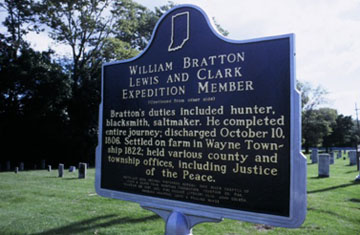 Waynetown is a close-knit, mostly rural farming community in western Montgomery County. But until several years ago, few residents knew a nationally historic figure was forever in their midst.
Waynetown is a close-knit, mostly rural farming community in western Montgomery County. But until several years ago, few residents knew a nationally historic figure was forever in their midst.
William Bratton, buried beneath a white obelisk in the Old Pioneer Cemetery on the east edge of town, was a private in the famed Corps of Discovery. Recruited by William Clark in Clarksville, Bratton accompanied Capts. Clark and Meriwether Lewis on the extraordinary 1803-1806 expedition.
“The man went the entire distance and back again, and is important to us today,” said Esther Duncan, a Lewis and Clark historian from nearby Wingate. She has worked tirelessly to bring Bratton the recognition she said he deserves. Duncan, who serves as secretary for the Ohio River Chapter of the Lewis and Clark Heritage Trail Foundation, was instrumental in having a historical marker for Bratton placed at the cemetery in 2002, just in time for the expedition’s bicentennial.
The expedition and its men teach us lessons still today about teamwork and cooperation. Duncan said the expedition rekindles her spirit in our nation’s democracy.
Born in Virginia in 1778, Bratton was living on the Kentucky frontier when the recruitment call went out for the military expedition to explore the West. A hundred or so men applied at Clarksville, but Lewis and Clark selected only nine before heading west down the Ohio River. Bratton was one of them.
Duncan, a Tipmont REMC consumer, said Bratton’s contributions to the expedition were significant. He was mentioned many times in the journals kept by the co-captains and others in the Corps. He was a skilled frontiersman and served the expedition as a hunter, blacksmith and saltmaker.
After the expedition returned to St. Louis in September 1806, Bratton was discharged. He then accompanied Lewis and Clark and several other original members of the Corps back to Clarksville in November of that year.
Details of the next 15 years of Bratton’s life are sketchy at times. Duncan noted he re-enlisted in the military in Kentucky in 1811. Toward the end of the War of 1812, he was captured and held briefly by the British.
In 1819, he married Mary Maxwell in Bowling Green, Ky. On Nov. 8, 1822, he purchased land on the Indiana frontier in Wayne Township, Montgomery County, and settled there. He and Mary had 10 children in all; eight lived into adulthood. His wife and four of their children are also buried in the pioneer cemetery beside him.
Bratton became a successful farmer and civic leader in Wayne Township. In 1824, he was appointed the township’s first justice of the peace. Duncan added that he no doubt drew on his military training and discipline to administer law and order. “Bratton was an upstanding man, and it shows,” she said. Some suggest he was also the first superintendent of schools in the area.
But apparently Bratton spoke little of the Lewis and Clark expedition as he aged. Duncan said she has uncovered almost no references Bratton made of his experiences. In some way, though, that may speak more about his character than if he had left volumes. Duncan likened him to the World War II soldiers who quietly returned to civilian life. “The real heroes,” she said, “you never hear from. I just wonder if William Bratton was just a modest man. He never said, ‘Well, when I was on the expedition, I did this and this …’”
Unlike many of his comrades in the Corps of Discovery, Bratton lived to an old age for his time. He died Nov. 11, 1841. He was 63.
Bratton left a historic mark on Indiana as a frontier leader, and on the nation as a member of the Corps. “He deserves all the credit, dignity and respect of a man of his stature,” said Duncan. “I call him a national hero.”



